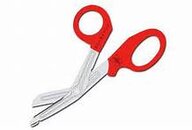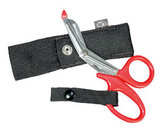My diving first aid kit is also my wilderness first aid kit so I also have a SAM splint and tensor bandages, for fractures. Duct tape and athletes tape are both useful for finishing off bandaging and holding it in place. Triangular bandages are great for slings, open fractures, impaled objects and for bandaging. An eye pad and large trauma pad (for abdominal wounds) are helpful. You're probably already aware of this but antiseptic wipes, alcohol, hydrogen peroxide, etc should only be used to clean around a wound. The wound itself should always be cleaned/irrigated with water. Gloves are also a necessity to protect the patient as well as yourself - no sense infecting a wound you've just spent a lot of time cleaning.
Now thats a heavy duty first aid kit!






